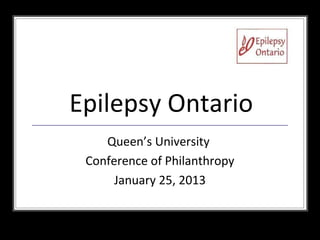
Epilepsy Ontario presentation January 2013
- 1. Epilepsy Ontario Queen’s University Conference of Philanthropy January 25, 2013
- 2. Epilepsy is a neurological disorder Epilepsy is not a disease or a psychological disorder. It is not contagious. It is a physical condition that causes sudden electrical discharges in the brain resulting in seizures which vary from one person to another in frequency and form. Epilepsy is the second most common neurological disorder next to headaches.
- 3. 1 in 100 Canadians live with Epilepsy 65,000 Ontarians live with epilepsy 10,000 are children 55,000 are adults Every year over 6,000 Ontarians are diagnosed with epilepsy
- 4. Symptoms of Epilepsy Epilepsy is best known for causing convulsions (seizures). But seizures can trigger a wide range of symptoms, from staring to falling to fumbling with clothes. Doctors divide seizures into several types depending on how the brain is affected. Each type has a distinct set of symptoms.
- 5. Types of Seizures Generalized Tonic Clonic Seizures •Formerly known as grand mal seizures are the most easily recognized. •They usually begin with a stiffening of the arms and legs, following by jerking motions. •Convulsions can last up to 3 minutes, after which the person may be tired and confused. •Involves abnormal electrical activity involving both sides of the brain. Absence Seizures Partial Seizures • Just one side of the brain is • Often described as staring affected. spells. • A person stops what he or she • Simple partial seizures may cause jerking motions or hallucinations, but is doing and stares vacantly for a the person often remains aware of few seconds, then continues as if nothing happened. what is happening. • Complex partial seizures, people • More common in children and may wander, mumble, smack their usually starts between the ages lips, or fumble with their clothes. of 4 and 12. • Some children experience up to • They appear to be conscious to observers, but are actually unaware 100 absence seizures in a day. of what they are doing.
- 6. Causes of Epilepsy Epilepsy may result from anything that disrupts the brain's natural circuitry, such as: Severe head injury Brain infection or disease Stroke Oxygen deprivation In nearly two-thirds of people with epilepsy, a specific cause is never found.
- 7. Our Mission Promoting independence and optimal quality of life for those living with seizure disorders by promoting information, awareness, support services, advocacy, education and research.
- 8. First Aid for Seizures Stay calm Most often a seizure will run its course and end naturally within a few minutes Time it If a seizure lasts more than 5 minutes or repeats without full recovery between seizures, call 911. Call 911 if the person is pregnant, has diabetes, is injured or if the seizure occurs in water. Call 911 if you know the person does not have epilepsy or a seizure disorder. Protect from injury Move sharp objects out of the way. If the person falls to the ground, roll them to their side and place something soft under head. If person wanders, stay close and gently steer them from danger. When seizure ends, provide reassurance and stay with person if they are confused. If person remains confused 1 hour after, call 911 DO NOT restrain person! NEVER put anything in a person’s mouth!
- 9. Programs and Services Support Research in Epilepsy Advocacy for Improved Quality of Life Educate clients on how to navigate healthcare system to obtain timely diagnosis and treatment Provide counseling and support to clients experiencing workplace discrimination Summerfest Camp An inclusive summer camp for kids aged 6 - 15 OBCL Epilepsy Scholarship Awards supporting youth achieve post secondary education Information and Awareness
- 10. Our Funding Epilepsy Ontario does not receive any government funding. We rely on the generosity of our donors and supporters, people just like you!
- 11. How can you help? Open up the dialogue about epilepsy Volunteer with Epilepsy Ontario Host an Event Join us for Purple Day – “Thumbs Up” events Join our Running/Walking team – Scotiabank Waterfront Marathon – October 20 2013 Subscribe to our e-newsletter email contact info to info@epilepsyontario.org
- 12. Like more info? Contact us at: 3100 Steeles Avenue West Suite 803 Markham Ontario www.epilepsyontario.org info@epilepsyontario.org Follow us